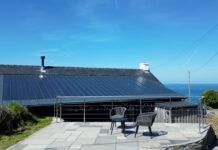Carl Thompson, technical manager for CA Group, discusses the importance of understanding the fire performance of roofing and cladding materials and their relationship with renewable energy solutions.
The subject of fire performance of roofing and cladding materials has, for understandable reasons, been of major focus in recent years, and while changes to legislation have focused on driving positive change across the construction industry, there remains many grey areas.
At the same time the importance of inclusion of renewable energy solutions, and accommodating the transition to electric vehicles, has grown, especially in light of the changes to Approved Document L making the use of renewable energy an intrinsic part of building design.
Yet these two significant initiatives, fire and renewables, risk being in conflict. Globally we have witnessed numerous examples of fires initiating from within failed PV arrays or faulty EV charging stations and then spreading to the building. The serious question being whether the current building regulations adequately protect a building against fires starting in such proximity to the fabric.
For roofs the general stipulation for industrial, commercial and logistics sector buildings is to comply with BS EN 13501-5 classification, which considers the risk of fire spreading across roofs and between buildings. The concern is that this classification may not necessarily offer adequate protection to the building in the event of an electrical fire starting in a PV module that could be in very close proximity to the roof material. The use of combustible insulation materials and roofing membranes (or potentially both) would often comply with building regulations and yet could present an increased risk in this scenario.
Similarly in a façade application, providing a cladding elevation with fire resistance rating for Integrity (E) and Insulation (I) is intended primarily to reduce risk to life and prevent fire spread to adjacent buildings – by definition offering protection from fires starting within the building. Where a fire might start in an EV charging station, possibly spreading to nearby electric vehicles including hybrid vehicles, this could present a risk of fire penetrating a building fabric from the external face. Cladding solutions offering fire resistance from inside-out might comply with building regulations but might not necessarily protect against the risk of external fires.
Compliance with building regulations already requires buildings of all types to use materials with minimum B-s3, d2 (BS EN13501-1) classification above 18m (Approved Document B2*, section B4 Table 12.1), and also to use a 300mm band of minimum A2-S3, d2 material above compartment walls (Approved Document B2, section B3 Diagram 8.2 and government FAQ** ). In addition to these compliance requirements we are now witnessing a growing trend of insurers insisting on minimum A2 limited combustibility insulation materials for roofs and walls where PV and EV units are likely to be used.
Understanding the balance between regulatory compliance and insurance risk assessment has become a fundamental requirement for any specialist contractor, manufacturer or system supplier for the UK market.
At CA Group we are fortunate enough to only use A1 Non-Combustible insulation in our CA Twin-Therm® and River-Therm® built-up systems. Furthermore our cladding systems offer a minimum 240 minutes Integrity (E) and 15 minutes Insulation (I) fire resistance for fire attack from either direction: inside to out, or outside to in. And of course to comply with insurance standards our systems offer LPCB LPS 1181 Grade ‘EXT-B’ as standard with enhanced options also available.
The question is whether the genuine benefits offered by such solutions is enough, should we be doing more to convince clients and their insurers of the real benefits in using low risk solutions, especially when such protection is available as standard and at no extra cost. Recent FPA (Fire Protection Association) guidance recommends the use of minimum A2 limited combustibility materials in proximity to any renewable energy solutions, which arguably limits the use of plastisol coated steel, widely accepted as the most appropriate roof covering material for industrial buildings to suit the UK climate.
Durability and suitability for maintenance access (foot traffic) is a consideration that needs to be taken into account and not just fire performance in isolation. The FPA guidance might steer specifiers towards other conclusions and not taking a holistic design approach.
What is the construction industry to do, caught between conflicting guidance, building regulation compliance and good practice? Time will tell, certainly this is not the end of the story and we’ll continue to update you as and when these important considerations are clarified.
*Approved Document B2 for England
**https://www.gov.uk/guidance/approved-document-b-fire-safety-frequently-asked-questions




